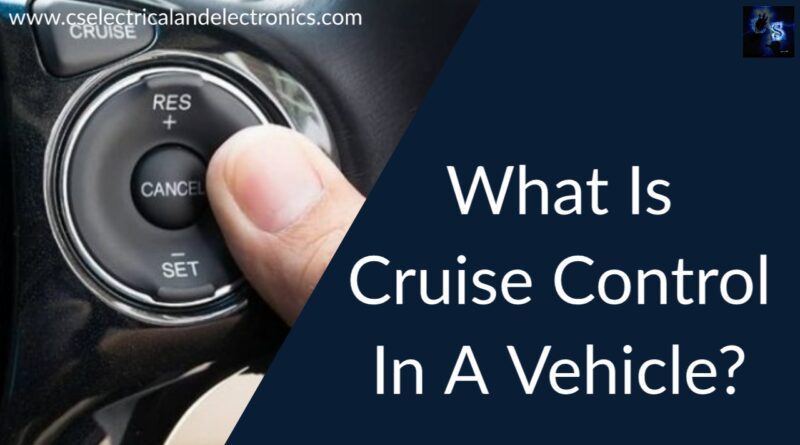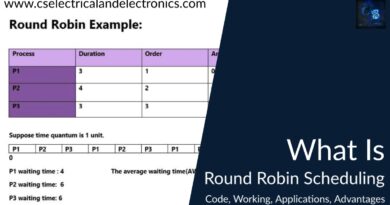What is Cruise Control in a Vehicle, Why is it Required, It’s Working
Hello guys, welcome back to my blog. In this article, I will discuss what is Cruise control in a vehicle, why is it required, how cruise control works, what will be the future of it in India, where it can be used, etc.
If you have any doubts related to electrical, electronics, and computer science, then ask questions. You can also catch me on Instagram – Chetan Shidling.
Also, read:
- Top 15 Applications of Embedded Systems, Embedded System Application
- Applications Of IoT, Internet Of Things, What Is IoT, Latest Technology
- Types Of Sensors Used In Mobile Phones, Sensors Used In Android Phones
What is Cruise Control in a Vehicle
Even though American highways are often broader and straighter, and destinations are farther between, cruise control is substantially more popular in American cars than it is in European cars.
As traffic grows, basic cruise control becomes less useful, but instead of becoming outdated, cruise control systems are adapting to this new reality. Adaptive cruise control, which allows your car to follow the car in front of it while constantly altering speed to maintain a safe distance, will be available in your car soon.
What is Cruise Control?
A cruise control system’s goal is to adjust the throttle-accelerator pedal linkage such that the driver’s desired speed is maintained without outside influence.
Long before automobiles were conceived, the first versions of cruise control were in use. James Watt, an inventor, and mechanical engineer developed a version that allowed steam engines to keep a constant speed up and down inclines in the early 17th century.
In the late 1940s, the idea of using an electrically operated device to vary road speeds and throttle accordingly was conceived, and cruise control as we know it today was born.
How Does Cruise Control Work?
The cruise control system regulates the speed of your vehicle by adjusting the throttle (accelerator) position, much like you do. Instead of using a pedal, cruise control uses a wire connected to an actuator to open the throttle valve.
Because the engine is an internal combustion engine, the throttle valve restricts the amount of air it can take in, affecting the engine’s power and speed.
The on/off switches aren’t very useful. The only effect of pressing the on button is to notify the vehicle that you will be pressing another button soon. The off button disables cruise control, even if it is set on. Instead of going off when the driver presses the brakes and on when the driver uses the set button, some cruise controls omit these buttons.
The set/accel button tells the car to keep going at its current speed. If you set the speed to 45 mph, the vehicle will remain at that pace. The car accelerates when the set/accel button is held down; tapping it once causes the car to accelerate by one mile.
When you hit the resume button after deactivating cruise control with the brake pedal, the vehicle will revert to its prior speed setting. Holding the coast button down causes the car to decelerate in the same way that removing your foot off the accelerator does. The car will slow down by one mph if you push the coast button once.
Each brake and clutch pedal features a switch that automatically disengages cruise control when the pedal is pressed, allowing you to turn it off with a simple tap on the brake or clutch.
The brain of a cruise control system is a small computer housed under the hood or beneath the dashboard. As described in the previous section, it connects to the throttle control as well as several sensors. The diagram below shows the inputs and outputs of a typical cruise control system.
A powerful cruise control system accelerates rapidly to the intended speed without overshooting and then maintains that speed with little deviation, regardless of how much weight is in the car or how steep the slope you drive up. Controlling the speed of a car is a well-known application of control system theory.
To govern the car’s speed, the cruise control system adjusts the throttle position, which necessitates the use of sensors to tell it of the speed and throttle position. It must also pay attention to the controls to determine the required speed and when to disengage. The most important input is the speed signal, which the cruise control system mainly relies on.
Let’s start with proportional control, which is one of the most basic control systems available. In a proportional control system, cruise control adjusts the throttle in proportion to the error, where the error is the difference between the target and actual speed. If the cruise control is set to 60 miles per hour and the vehicle is moving at 50 miles per hour.
To sum up, The ACC significantly reduces the driver’s workload. Active safety systems like adaptive cruise control, electronic stability control, and lane-keeping assistant can help to increase safety by reducing the number of traffic accidents.
I hope this article may help you all a lot. Thank you for reading.
Also, read:
- 10 Tips To Maintain Battery For Long Life, Battery Maintainance
- 10 Tips To Save Electricity Bills, Save Money By Saving Electricity
- 100 (AI) Artificial Intelligence Applications In The Automotive Industry
- 100 + Electrical Engineering Projects For Students, Engineers
- 1000+ Control System Quiz, Top MCQ On Control System
- 1000+ Electrical Machines Quiz, Top MCQs On Electrical Machines
- 1000+ Electronics Projects For Engineers, Diploma, MTech Students
- 1000+ MATLAB Simulink Projects For MTech, Engineering Students
Author Profile
- Content Writer
Latest entries
 All PostsAugust 25, 2021Top 16 Highest Paying Engineering Jobs in the USA For Freshers
All PostsAugust 25, 2021Top 16 Highest Paying Engineering Jobs in the USA For Freshers All PostsAugust 23, 2021Top 10 Smart Cities In The World, Best Cities To Visit In The World
All PostsAugust 23, 2021Top 10 Smart Cities In The World, Best Cities To Visit In The World All PostsAugust 21, 2021Top 20 VLSI & Embedded Systems Projects for Mtech Students
All PostsAugust 21, 2021Top 20 VLSI & Embedded Systems Projects for Mtech Students All PostsAugust 21, 2021Top 20 Power Systems Projects For MTech Students, Engineering Students
All PostsAugust 21, 2021Top 20 Power Systems Projects For MTech Students, Engineering Students








